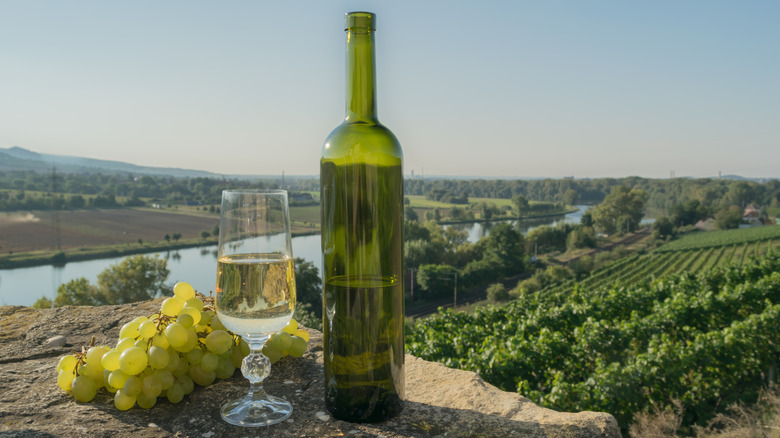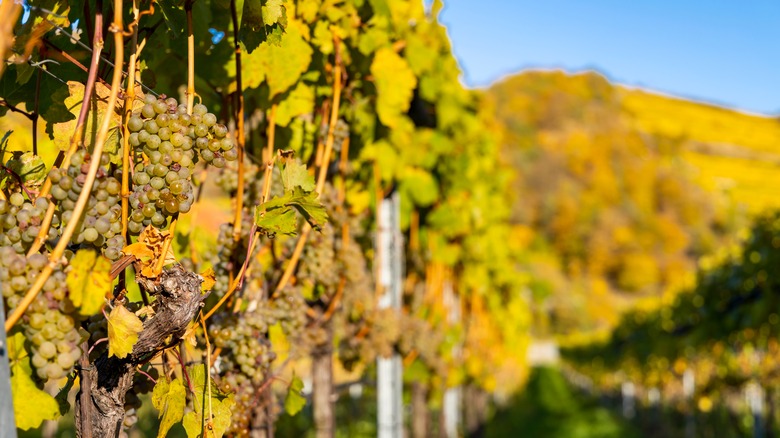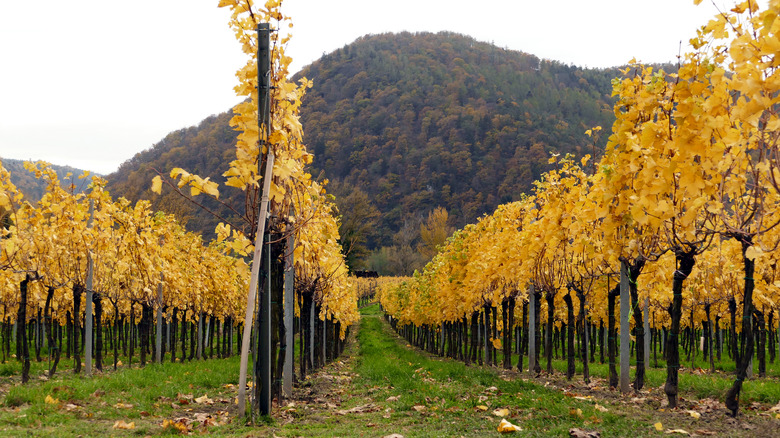The Austrian Origins Of Grüner Veltliner Wine
Grüner Veltliner is a varietal of white wine grape that hails from Austria and is becoming popular worldwide. The wine critic, author, and wine collector Jancis Robinson reports that it is Austria's most widely planted grape, representing one vine in every three grown there. And in the grape's origins of Lower Austria (Neiderosterreich), that ratio is one vine in every two. Grüner Veltliner vines are now planted internationally, well beyond Austria's borders in the Czech Republic, Slovakia, Hungary, New Zealand, and the U.S. — possibly in your own backyard. However, according to MasterClass, most of this wine still comes from Austria.
Grüner Veltliner's favorite places to grow, according to Decanter Magazine, are along the Danube River, in the Wachau and Danube Valleys, as well as in Traisantal and Weinviertel of lower Austria. These regions, with their mineral-rich soil and high rainfall, give the grape its versatile character. In the Wachau, for instance, the wine is sorted into three different classifications based on their natural amounts of alcohol by volume (ABV), starting at around 11.5% and going up from there, according to Austrian Wine.
An Austrian original
Veltlin, according to Wine Folly, was a region in Austria in the 16th century, in what is now modern-day Italy. And despite sharing the name, there is no genetic link between Grüner Veltliner grapes and any other Veltliner grapes (via MasterClass). The Grüner variety is a product of cross-breeding the French grape, Savignin (also known as "Traminer") with a now nearly extinct Austrian grape called St. Georgener-rebe. The result is a versatile grape that grows well in cooler climates and creates a wide variety of white wines from bright and refreshing to nutty, rich, and even creamy, according to Wine Folly. In its younger, less expensive vintages, GrüVue is described as having a hint of effervescence — a crisp acidic hit that quickly livens up the palate.
The wine's name is hard to pronounce for most English speakers, and many wine merchants have taken to simply calling it Grüner. Others have shortened the two words, and called it, "GrüVe" as in "groovy" according to Quench Magazine, and who doesn't want groovy wine? Grüner is German for green, which doesn't refer to the color of the wine, but rather the grape, and its signature citrus flavors, combined with herbaceous flavors, and a hint of white pepper.
Food friendly, diverse and versatile
The young bottlings of "GrüVe" are inexpensive and often sold at local Austrian Heuriger, or taverns and are also used as the base wine in bottles of Sekt, or Austrian sparkling wine, according to Wine Enthusiast. But Austrian Grüner Veltliner is also available in most of its classifications in most markets, including the U.S., according to Vivino. You may, however, have to search a bit harder and pay a bit more for the bottles marked "reserve," which have been aged longer in oak barrels.
As with most white wines, Grüner Veltliner pairs well with spicy food, including Asian cuisine, fatty pork dishes, and cheese and meat appetizers. Its flavor profile has a nice, assertive acidity, and notes of peach and pear, along with its core citrus flavors. VinePair quotes Wolfgang Puck as saying that the perfect meal is a plate of schnitzel with an Austrian Grüner Veltliner,
If you're looking for value, it's hard to beat a bottle of GrüVe, which in its younger and lighter classifications, will only set you back between $15.00 to $20.00, according to Drizly. In that way, this variety has become Austria's groovy little love note to the wine world.


